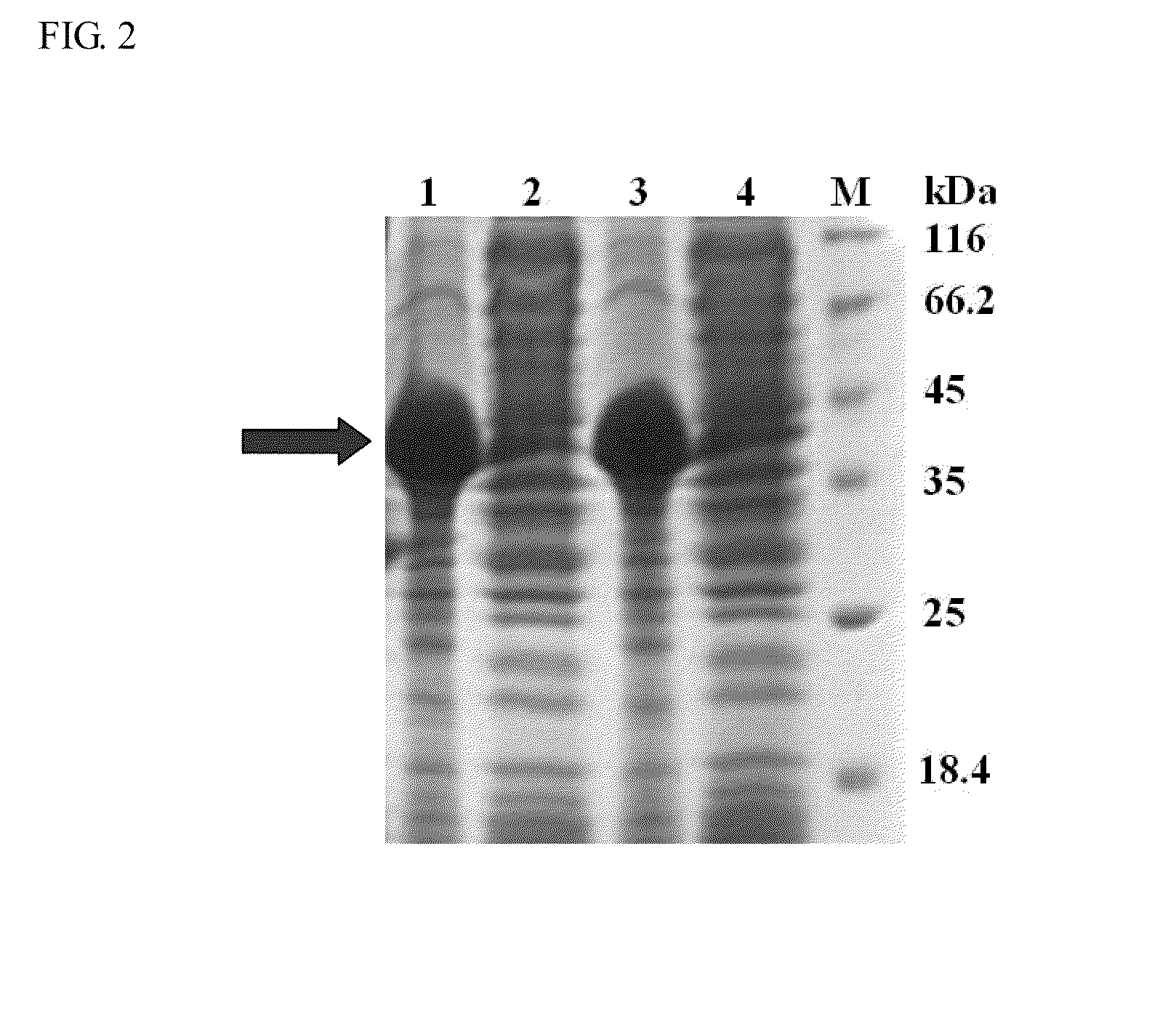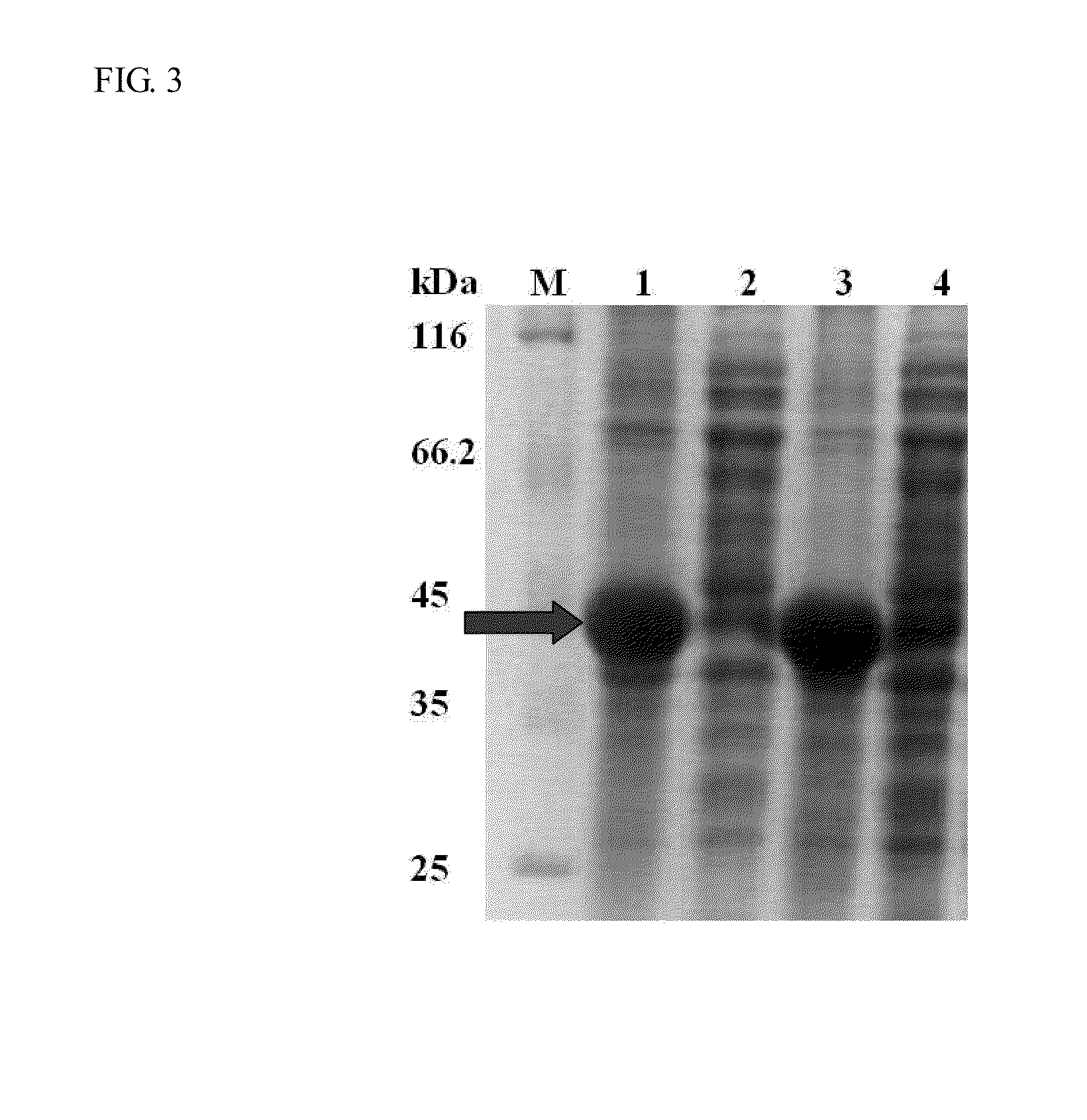Starch Binding Domain and Use Thereof
a starch binding and domain technology, applied in the field of starch binding domains, can solve the problems of high cost of purification columns, inconvenient purification processes, and laborious purification processes
- Summary
- Abstract
- Description
- Claims
- Application Information
AI Technical Summary
Benefits of technology
Problems solved by technology
Method used
Image
Examples
example 1
(A) Construction of Plasmids
[0037]The schematic representation of the recombinant constructs is shown in FIG. 1. The fragments of eGFP, linkers and SBD were amplified by PCR with the designed primers, and their sequences are shown in Table 1. The linker region is substituted with five linker candidates (RoLK: linker of Rhizopus oryzae GA, PH: six histidines, PK: eight lysines, PPT: a threonine plus four repeats of proline-threoline [T(PT)4], and 58L: the region between the cutting sites of SpeI and NcoI on pET39b(+)). The PCR reactions were prepared as follows: 10 ng template, 0.5 μl of each primer (10 μM), 5 μl reaction buffer (10×), 5 μl deoxynucleotides (2.5 mM), 0.8 μl Ex Taq DNA polymerase (Takara Mirus Bio, Japan, 5 U / μl) in a final volume of 50 μl with ddH2O. This mixture was subjected to 1 cycle of 95° C. for 5 min and 30 cycles of 95° C. for 30 sec (Denaturation), 53° C. for 30 sec (Annealing), 72° C. for 20 sec to 2 min (Extension) and 1 cycle of 72° C. for 5 min.
TABLE 1Sy...
example 2
(A) Effect of pH on Binding Ability
[0052]In the experiment of investigating the pH effects on binding ability, purified fusion proteins with a concentration of 16 μM were stirred in a buffer with various pH values and a final concentration of corn starch (Sigma-Aldrich, EC 232-679-6, USA) as 0.1 mg / ml at 25° C. for 1 hr. The binding was carried out at a pH value, ranging from 2.0 to 11.0, where the buffers included 100 mM glycine / HCl (pH 2-3), 100 mM sodium acetate / acetic acid (pH 4-5), 100 mM Na2HPO4 / NaH2PO4 (pH 6-7), 100 mM Tris / HCl (pH 8) and 100 mM glycine / NaOH (pH 9-11). The free fusion protein concentration in the supernatant before and after the binding was determined by BCA assay. The relative binding ability of the fusion protein assayed at pH 5.0 was normalized as 100%.
(B) Effect of Temperature on Binding Ability
[0053]In the investigation of temperature effects on starch binding ability, purified fusion proteins at a concentration of 16 μM were stirred in binding buffer (5...
example 3
(A) NMR Spectroscopy for Structure Determination
[0059]NMR data were acquired on a Bruker Avance 600 MHz or 800 MHz spectrometer. For structure determination, 1 mM RoCBM21 (either unlabeled, 15N-labeled, or 13C, 15N-double labeled) was dissolved in 10 mM sodium acetate, pH 4.5, and subjected to NMR experiments at 25° C. The protein concentrations were quantitated by Bio-Rad Protein Assay. Backbone assignment was accomplished with HNCA, HN(CO)CA, HNCACB, CBCA(CO)NH, HNCO, and HN(CA)CO experiments (Cavanagh, J. et al., (1996) Protein NMR spectroscopy, Academic Press Inc.). Because RoCBM21 contains a relatively high proportion of aromatic residues, the assignment of aromatic side chains was assisted by HBCBCGCDHD and HBCBCGCDCEHE experiments (Yamazaki, T. et al., (1993) J. Am. Chem. Soc. 115, 11054-11055). The assignments of remaining atoms were accomplished using both homonuclear two-dimensional nuclear Overhauser enhancement spectroscopy (NOESY) and 15N heteronuclear single-quantum co...
PUM
| Property | Measurement | Unit |
|---|---|---|
| temperature | aaaaa | aaaaa |
| width | aaaaa | aaaaa |
| PH | aaaaa | aaaaa |
Abstract
Description
Claims
Application Information
 Login to View More
Login to View More - R&D
- Intellectual Property
- Life Sciences
- Materials
- Tech Scout
- Unparalleled Data Quality
- Higher Quality Content
- 60% Fewer Hallucinations
Browse by: Latest US Patents, China's latest patents, Technical Efficacy Thesaurus, Application Domain, Technology Topic, Popular Technical Reports.
© 2025 PatSnap. All rights reserved.Legal|Privacy policy|Modern Slavery Act Transparency Statement|Sitemap|About US| Contact US: help@patsnap.com



